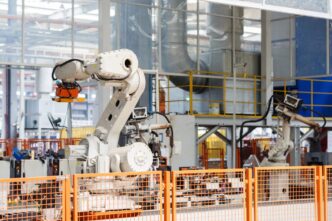A cobot application is helping businesses improve productivity and safety by allowing humans and collaborative robots to work side by side. Unlike traditional industrial robots that require isolation, cobots are designed with advanced sensors and safety features, making them ideal for shared workspaces.
They take on repetitive or hazardous tasks, enabling employees to focus on higher-value work while reducing the risk of workplace injuries. In this article, we’ll explore how cobot applications enhance both efficiency and safety across different industries.
Key Features of Cobots
Cobots are robots designed to work safely and efficiently alongside humans in shared workspaces. Their main features include:
- Advanced Human Detection Sensors
Cobots use sensors like cameras and proximity detectors to notice when people are nearby. They adjust their movements automatically to work safely without barriers.
- Built-in Safety Features
Safety is a top priority. Cobots monitor speed and force, detect collisions, and include emergency stop functions. If a person enters the workspace, the cobot can slow down, stop, or adjust its motion to prevent accidents.
- Easy Programming and Flexible Deployment
Cobots are user-friendly and can often be programmed through demonstration, requiring minimal specialized skills. Their lightweight and modular design makes them easy to redeploy across different tasks and workstations.
- Compact and Adaptable Design
Smaller and lighter than traditional industrial robots, cobots integrate seamlessly into existing workflows. Their versatility allows them to operate in a variety of environments and handle multiple tasks, boosting productivity and flexibility.
These features make cobots valuable for improving efficiency, safety, and teamwork in industries like manufacturing, healthcare, and logistics.
How Cobots Improve Productivity
Cobots help industries operate more efficiently by automating repetitive tasks, reducing errors, and allowing humans to focus on complex, high-value work. Here’s how they enhance productivity:
- Handling Repetitive Tasks
Cobots do boring or physically demanding tasks such as assembly, packaging, and machine tending. This allows human workers to focus on more complex tasks, reduces fatigue, and lowers the risk of repetitive strain injuries.
- Reducing Errors and Rework
Cobots perform tasks with accuracy and consistency, reducing errors and the need for rework. This improves product quality and keeps production running more smoothly.
- Enabling Focus on Complex Work
Cobots handle routine tasks, giving workers more time to solve problems, make decisions, and use their creativity. This not only boosts productivity but also makes work more rewarding.
- Increasing Workflow Efficiency
Cobots can operate continuously without breaks, boosting throughput and reducing downtime. Their ability to work safely alongside humans allows for more flexible and efficient workflows.
Cobots increase productivity, reduce errors, and improve quality across industries.
How Cobots Enhance Safety
Cobots are enhancing workplace safety by taking on dangerous tasks, lowering injury risks, and enabling real-time monitoring. Here’s how they make work environments safer:
- Handling Hazardous Tasks
Cobots perform physically demanding or risky tasks, such as lifting heavy loads, handling dangerous materials, or repeating the same motions. This reduces the risk of human injuries from overexertion or exposure to harmful substances.
- Reducing Workplace Injuries
Cobots have sensors and safety features that help them notice people to prevent accidents. This lets them work closely with humans without causing harm.
- Preventing Repetitive Strain Injuries
Cobots handle repetitive or physically demanding tasks, helping reduce worker fatigue, strain, and the risk of injuries. Workers can spend more time on skilled tasks, making their work safer and more productive.
- Real-Time Safety Monitoring
Cobots continuously track their activities and provide instant feedback. This allows potential risks to be detected and addressed before accidents occur, keeping the workplace safer.
Cobots improve safety by handling hazardous tasks, reducing injury risks, preventing repetitive strain injuries, and offering real-time monitoring. Their integration enhances both safety and efficiency across industries.
Industry Applications of Cobots
Cobots are helping industries by doing tasks that are repetitive, dangerous, or require great accuracy. Here’s how different industries use them:
- Automotive – Assembly Line Support
Cobots help by loading and unloading materials into machines, speeding up production and reducing the risk of injuries. This not only speeds up production but also reduces the risk of injuries. They also perform assembly tasks with great accuracy, ensuring consistent results when putting together electronic components, car parts, or delicate medical devices.
- Electronics – Precision in Tight Spaces
In electronics manufacturing, cobots help with soldering, inspecting, and moving small parts. Their high precision lets them work accurately with tiny components in tight spaces.
- Healthcare – Labs and Patient Assistance
Cobots automate lab work such as handling samples, pipetting, and labeling, which reduces errors and improves efficiency. They also help patients with rehabilitation by guiding exercises and giving instant feedback.
- Food & Beverage – Packaging and Quality Control
Cobots handle packaging, labeling, and quality checks, reducing errors and waste. They can also carefully handle delicate food items, lowering the risk of contamination.
- Logistics – Order Fulfillment and Material Handling
Cobots inspect products, measure tolerances, and ensure quality. In warehouses, cobots help workers by handling packing, sorting, and stacking, making the work faster and easier.
Cobots boost productivity, safety, and quality by handling routine or risky tasks alongside humans.
Best Practices for Implementing Cobots
Effectively using collaborative robots (cobots) requires careful planning in employee training, workflow integration, performance monitoring, and safety management. The following best practices can help ensure successful deployment:
-
Train Employees to Work Safely with Cobots
Proper training is essential for employees to operate safely alongside cobots. Training should include:
- Safe operation and emergency procedures.
- Understanding cobot capabilities and limitations.
- Hands-on practice with programming and basic maintenance.
- Guidelines for collaborating with cobots during tasks.
Well-trained employees feel confident, work more safely, and contribute to higher productivity.
-
Integrate Cobots into Existing Workflows
Cobots perform best when seamlessly integrated into current processes. Key steps include:
- Identifying tasks suitable for automation.
- Designing workstations for both humans and cobots.
- Ensuring compatibility with existing equipment and systems.
- Using flexible programming to handle varying tasks
This approach reduces disruptions and improves overall workflow efficiency.
-
Monitor and Optimize Cobot Performance
Regular performance monitoring ensures cobots operate at peak efficiency. Tracking metrics such as speed, accuracy, and downtime helps detect issues early and identify opportunities for improvement.
-
Conduct Safety Audits and Continuously Improve
Regular safety audits help identify potential risks and prevent accidents. Follow standards such as ISO/TS 15066, and continually update procedures to keep pace with technological and workflow changes.
Following best practices helps companies use cobots to boost safety, productivity, and employee satisfaction.
The Future of Collaborative Robots (Cobots)
Cobots are advancing rapidly thanks to improvements in AI, greater affordability, and enhanced human-robot collaboration.
- Smarter Cobots: AI and machine learning enable cobots to learn from experience, adapt to new tasks, and perform complex operations, making them versatile across different industries.
- Accessible for SMEs: Cobots are now affordable and easy to use, allowing smaller companies to handle tasks like assembly, packaging, and quality checks more efficiently.
- Enhanced Collaboration: Cobots have smart sensors and controls that let them work safely with people, helping them share tasks and make decisions together.
Collaborative cobots are helping businesses of all sizes increase productivity, enhance safety, and improve operational flexibility.














